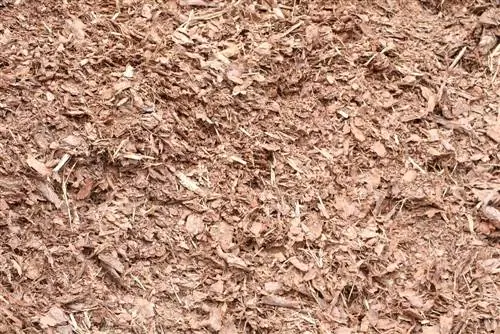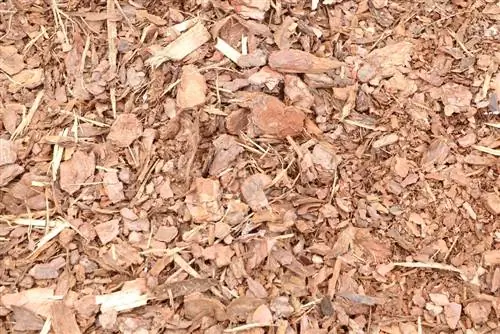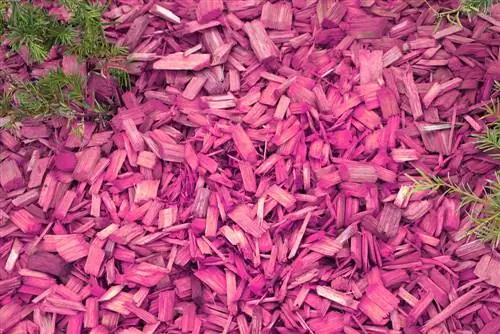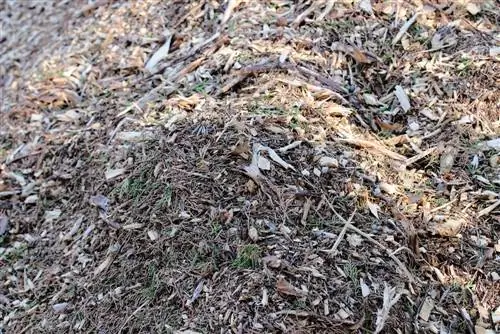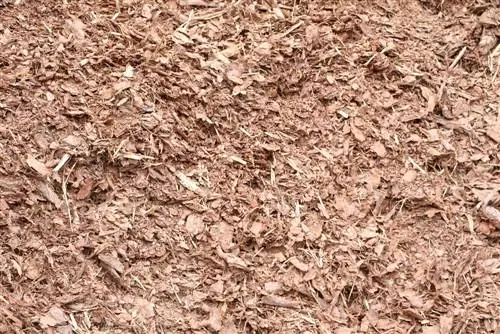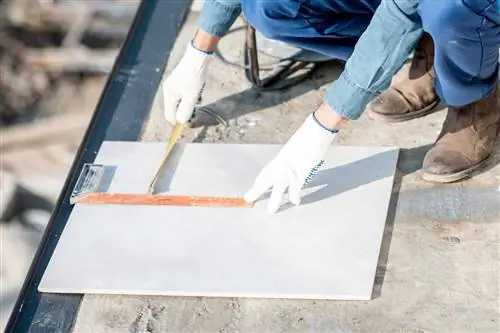- Author admin [email protected].
- Public 2023-12-17 03:39.
- Last modified 2025-01-24 12:45.
Wood chips are known from landscaping and are used in a variety of ways. Private gardeners usually work with bark mulch to protect their beds. Above all, thewood chips are considered a cheap alternative in contrast to bark mulch. The following article explains which material is better and how to apply the covering correctly.
Wood chips or bark mulch?
The first step in deciding whether to use wood chips or mulch in the garden should be to think about what the material will be used for in the first place. Because bark mulch is more expensive to purchase and sometimes cheaper wood chips can be used. The bark in the mulch contains tannins that the wood chips do not have. Therefore, the decision depends on the following factors:
- Bark mulch is more expensive
- but a little more suitable for beds
- Wood chips are more useful for garden paths and playgrounds
- these are cheaper and last longer
- can also be purchased colored
Tip:
A he althy mix of mulch and wood chips in the garden is optimal. The more nutrient-rich bark mulch is placed on the beds, while the cheaper wood chips, which are available in many colors, are placed on all other surfaces, such as paths, seating areas or play areas.
Benefits of wood chips
The big advantage here is primarily the price, because it is primarily a waste product from woodworking. This is how the wood chips are obtained from the processing of coniferous trees. But there are other advantages to choosing wood chips:
- very long lasting
- can remain outdoors for at least three years
- good elasticity and permeability
- prevent siltation or drying out of the soil
- Wood chips prevent weed growth
- has warming properties
- Wood chips are low in dust
Tip:
Of course, in addition towood chips, mulch also has the above-mentioned positive properties, but it is more expensive to purchase and unfortunately does not last as long and has to be replaced after just one winter, which is what in turn represents a cost factor.
Wood chips Use in the garden
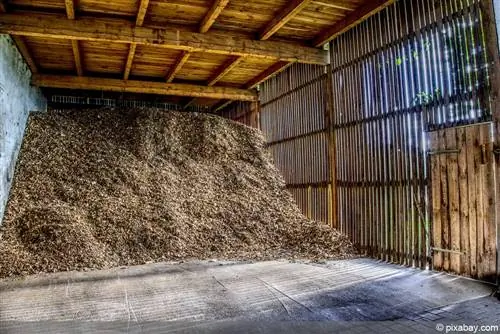
In the garden, wood chips are usually used to cover the beds. The material can be applied to the bed regardless of the season. This protects the bed from frost in winter and from drying out in summer. Nutrients contained in the wood chips are carried into the soil by rain and thus to the plants. But there are also other possible uses for the wood chips on your own property:
- on play areas for children
- can serve as a fall protection surface under playground equipment
- set accents in the garden with colored schnitzels
- natural tones and bold shades are available
- as floor covering for garden paths and seats
Tip:
It makes sense to spread the material out, especially if children could fall from a height of at least 60 cm. Because it is shock-absorbing and reduces the risk of injury. Colored schnitzels are already available in stores, which the children will like.
Laying wood chips correctly
Before the schnitzels are spread on the ground, it should first and foremost be cleared of any weeds. This also applies to mulching. Before the covering is spread, the soil must also be supplied with fertilizer, nitrogen and horn shavings. Then proceed as follows:
- Fill the wheelbarrow and drive it to the desired location
- spread over the bed or garden path with a shovel
- smooth with rake
- on paths or as a fall protection layer at least ten centimeters
Tip:
The ground under a swing or gymnastics equipment can also be partially excavated. The resulting cavity is filled to the top with wood chips, so in the worst case the children fall softly.
Benefits of bark mulch
Bark mulch is made from chopped tree bark. Pine, spruce and fir are mainly used here. Pine bark is of higher quality and also exudes a pleasant scent. As a rule, pine mulch is also placed on the beds to protect the plants and offers the following good properties:
- especially suitable in perennial beds
- protects the soil from erosion
- compensates temperature fluctuations
- protects against frost in winter
- in summer from too much heat
- serves as fertilizer
- can prevent weeds
Tip:
Not all plants tolerate bark mulch. Rose beds should not be covered with the shredded bark, as this contains tannins that are harmful to roses and could reach the roots of the plants through the soil.
Bark mulch use in the garden
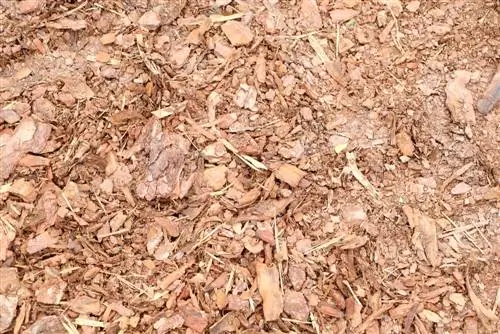
Mulch is used in the garden primarily to cover beds and on the ground of larger potted plants and can thus protect. But it is also used as a floor covering on paths and the mulch protects under the play equipment, as do the wood chips. However, rough quality should be used here. Because unlike the one laid out on the bed, the surface on paths and on a small playground in the garden has to withstand a lot. In addition, a lot of the expensive material has to be used. It is therefore advisable to choose the cheaper version of wood chips.
Mulch properly
When laying even the better quality pine mulch, the most important thing is the right height. Because neither too much nor too little spread on the bed will help the plants. It is helpful to have a leaf broom or rake on hand for spreading. With these devices, the pine bark can be easily and carefully distributed around the plants. In order to get the material to the bed, you should not do without a wheelbarrow. The material is then applied to the bed with the shovel and distributed with the rake. Gardening gloves should also be worn to protect against skin damage to the hands. Particular attention should be paid to the following points when laying:
- Thickness of the layer between five and seven centimeters
- If it is too thick, mold will form
- protection is not guaranteed if the layer is too thin
- Soil can dry out in heat
- In winter, frost can reach the roots
- Weeds can prevail
Tip:
Since mulch is a natural material that decomposes over time, it must be renewed again and again. After one year at the latest, it must be checked whether the ideal height on the floor is still present and added.
Pay attention to quality seals
When bark mulch is purchased commercially, the main thing to pay attention to is the quality, even if the product is a little more expensive. Pine bark is considered the Mercedes among species. Because this material lasts longer and has even more nutrients. Particular emphasis should be placed on the size of the individual pieces of bark. There is fine, medium and very coarse pine mulch. The medium quality, which usually has pieces between 16 and 25 mm in size, is the best for the bed. If the mulch is very coarse, the moisture can escape from the soil more quickly; if it is too fine, it can be blown away more easily in the wind. The following should also be noted:
- has a high proportion of cadmium
- Trees absorb the heavy metal from the ground
- this settles in the bark
- then it gets into the ground via the pieces of bark
- pay attention to RAL quality mark 250/1
- ensures that the legally set limits have been adhered to
Tip:
Very important when purchasing the bark mulch is to pay attention to its freshness. If the decomposition process is already too advanced when you buy it, it can no longer be used. If the material exudes a pleasant, fresh forest scent, then it is young and can be used. Wood chips decompose much more slowly, so you don't have to pay attention to their age when buying.
Alternative: use mulch film
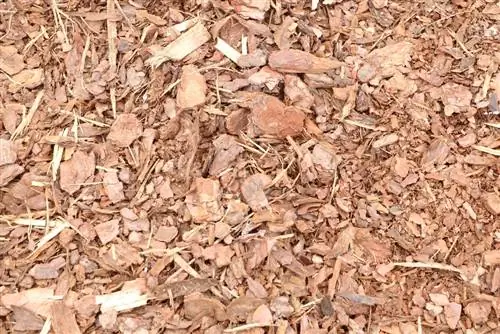
Mulch film can also be used for a better result in the garden bed. In this way, particularly stubborn weeds can be removed from the bed. Mulch film is also available from well-stocked garden shops. When using it, you should proceed as follows:
- Remove any weeds from the ground
- Fertilize
- Apply foil
- should stay in place for at least two years
- Cut suitable holes in the mulch film for plants
- this also works with later new plantings
- Foil in the bed is not particularly decorative
- so cover with wood chips or bark mulch
- so the foil is hidden and weighed down at the same time
Various types of mulch films are available commercially. For example, different thicknesses of films made from plastic but also from cardboard-like material. When buying, it is important to pay attention to the water permeability, otherwise the top covering will be washed away. Congested water can also damage plant growth because it sits heavily on the soil and compacts it.

